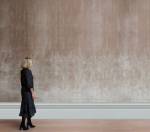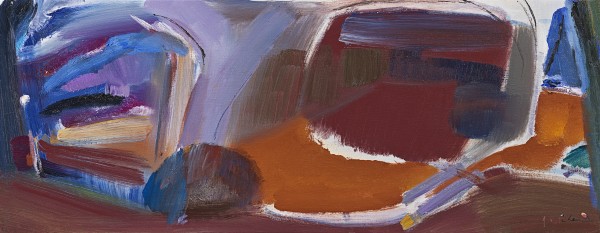Ivon Hitchens
Forest, 'O hurry to the ragged wood'
Oil on canvas: 20.2 x 41.5 (in) / 51.4 x 105.4 (cm)
Signed lower right: Hitchens; signed, dated and inscribed on the artist's label attached to the stretcher: Forest. "O hurry to the ragged wood" / 1971 / by Ivon Hitchens / Petworth / Sussex
This artwork is for sale.
Please contact us on: +44 (0)20 7493 3939.
Email us
IVON HITCHENS CBE
London 1893 - 1979 Petworth
Ref: CA 185
Forest, ‘O hurry to the ragged wood’
Signed lower right: Hitchens; signed, dated and inscribed on the artist's label attached to the stretcher: Forest. “O hurry to the ragged wood” / 1971 / by Ivon Hitchens / Petworth / Sussex
Oil on canvas: 20 ¼ x 41 ½ in / 51.4 x 105.4 cm
Frame size: 28 ⅝ x 50 in / 72.7 x 127 cm
Provenance:
Waddington Galleries, London
Johnathan Clark, London;
private collection, UK
Exhibited:
London, Waddington Galleries, Ivon Hitchens: Retrospective exhibition, 16th May-9th June 1973, cat. no.30
Literature:
Alan Bowness (ed.), Ivon Hitchens, Lund Humphries, London, 1973, illus., in colour no.112
The freedom and airy lightness, the apparent spontaneity of this painting are characteristic of Hitchens’ work in the last decade of his life. As he said at the time, only half jokingly, drawing was something he had outgrown, now he just wanted to paint. In other words, he wanted to dispense with the carefully considered skeleton or armature underpinning his pictures and instead dare to paint his immediate impression in front of the motif. It hardly needs saying that the structure is still there in these late paintings, but even more subtly concealed.
The present work is a fine example of this. Starting from the pale blue centre, the eye travels left, following the verticals of progressively darkening blue until blocked at the canvas edge. It then returns from this cool area to explore the warmer righthand side of the painting where the smaller, more varied shapes invite one into the painting. In the foreground of the canvas we have precisely the opposite dynamic: large areas of warm purple on the left, cool green on the right. But more important to the appreciation of the painting than picking it to pieces is to accept that it is a largely abstract arrangement of colour patches sufficient unto itself. The link with the subject in the natural world is tenuous in the extreme—both form and colour have a life of their own, needing no external validation.
This is reflected in the title of the painting. By this stage in his career Hitchens was hard put to it to find a picture title which he hadn’t used before and which was not too descriptive, thereby setting the viewer off on the wrong foot, trying to identify trees, water or whatever. Borrowing a line from Yeats’ poem The Ragged Wood gave just enough of a hint as to the context of the painting without being over-precise as to its subject. In short, the subject is largely the painting itself.
Peter Khoroche June 2022
Sydney Ivon Hitchens was the only child of artist Alfred Hitchens and Ethel Margaret Seth-Smith, a talented amateur artist. Following his early education at Conamur School, Sandgate, Kent, Hitchens attended Bedales School, Hampshire from 1903 until acute appendicitis cut short his school days and sent him on a recuperative voyage to New Zealand. Hitchens’ art education began at St John’s Wood School of Art, London from 1911 and continued at the Royal Academy Schools from 1912-16. He returned to the RA Schools between 1918-19, following two years’ service in hospital supply during the First World War. Still not fully recovered from his youthful illness, Hitchens was declared unfit for active service in 1916.
After graduating from the RA Schools, Hitchens moved into a studio at 169 Adelaide Road, Hampstead in 1919 and later became part of a circle of avant-garde British artists including Barbara Hepworth, Henry Moore, Paul Nash and Ben Nicholson living in Hampstead in the 1930s. In 1920 he exhibited at the first exhibition of the Seven & Five Society, becoming a member that same year. Hitchens was elected a member of the London Artists’ Association in 1929, of the London Group in 1931 and of the Society of Mural Painters in 1937. The artist exhibited with the Leicester Galleries from 1940 until 1960, when he moved to the Waddington Galleries. Hitchens married Mary Cranford Coates on 27th June 1935. He and his wife left London in 1940 with their only child, John, for a caravan at Greenleaves, Lavington Common near Petworth, Sussex, after a bomb landed next door to his Hampstead studio. For the next forty years, Hitchens’ six acres of woodland near Midhurst became his home, place of study and constant source of inspiration. In 1951 the artist won a purchase prize at the Festival of Britain exhibition, 60 paintings for ‘51. Hitchens completed a mural at Cecil Sharp House, Regent’s Park Road in 1954, and installed another mural at the University of Sussex in 1962. In 1956 the British Council arranged a retrospective exhibition of his work for the Venice Biennale. In 1957 Hitchens was created CBE. A major retrospective of Hitchens’ work was arranged by the Arts Council at the Tate Gallery, London in 1963. In 1979 a third retrospective exhibition was held at the RA Diploma Galleries.





























